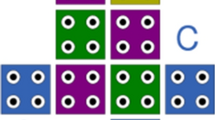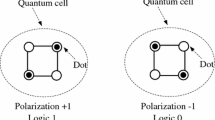Abstract
Quantum-dot Cellular Automata (QCA) is a new technology for designing digital circuits in Nanoscale. This technology utilizes quantum dots rather than diodes and transistors. QCA supplies a new computation platform, where binary data can be represented by polarized cells, which can define by the electron’s configurations inside the cell. This paper explains QCA based combinational circuit design; such as half-adder and full-adder, by only one uniform layer of cells. The proposed design is accomplished using a novel XOR gate. The proposed XOR gate has a 50% speed improvement and 35% reduction in the number of cells needed over the best reported XOR. The results of QCADesigner software show that the proposed designs have less complexity and less power consumption than previous designs.


















Similar content being viewed by others
References
G.Q. Zhang, A. Roosmalen, More than Moore: Creating High Value Micro/Nanoelectronics Systems (Springer, Berlin, 2009)
E. Alkaldy, A.H. Majeed, Bin Zainal, D. Bin Md Nor, Optimum multiplexer design in quantum-dot cellular automata. Indones. J. Electr. Eng. Comput. Sci. 17, 148–155 (2020)
B. Sen, M. Dutta, M. Goswami, B.K. Sikdar, Modular design of testable reversible ALU by QCA multiplexer with increase in programmability. Microelectron. J. 45, 1522–1532 (2014)
S. Sheikhfaal, K. Navi, S. Angizi, A.H. Navin, Designing high speed sequential circuits by quantum-dot cellular automata: memory cell and counter study. Quantum Matter 4, 190–197 (2015)
A.H. Majeed, E. Alkaldy, BinZainal, D. BinMdNor, Synchronous counter design using novel level sensitive T-FF in QCA technology. J. Low Power Electron. Appl. 9, 27 (2019)
A.H. Majeed, E. Alkaldy, M. Zainal, K. Navi, D. Nor, in Optimal Design of RAM Cell Using Novel 2:1 Multiplexer in QCA Technology, Circuit World (2019)
A. Majeed, E. AlKaldy, S. Albermany, An energy-efficient RAM cell based on novel majority gate in QCA technology. SN Appl. Sci. 1, 1–8 (2019)
K. Navi, R. Farazkish, S. Sayedsalehi, M. RahimiAzghadi, A new quantum-dot cellular automata full-adder. Microelectron. J. 41, 820–826 (2010)
M. Gladshtein, Design and simulation of novel adder/subtractors on quantum-dot cellular automata: radical departure from Boolean logic circuits. Microelectron. J. 44, 545–552 (2013)
R. Farazkish, F. Khodaparast, Design and characterization of a new fault-tolerant full-adder for quantum-dot cellular automata. Microprocess. Microsyst. 39, 426–433 (2015)
S. Hashemi, K. Navi, A novel robust QCA full-adder. Procedia Mater. Sci. 11, 376–380 (2015)
A. Roohi, R.F. DeMara, N. Khoshavi, Design and evaluation of an ultra-area-efficient fault-tolerant QCA full adder. Microelectron. J. 46, 531–542 (2015)
M. Mohammadi, M. Mohammadi, S. Gorgin, An efficient design of full adder in quantum-dot cellular automata (QCA) technology. Microelectron. J. 50, 35–43 (2016)
T.N. Sasamal, A.K. Singh, A. Mohan, An optimal design of full adder based on 5-input majority gate in coplanar quantum-dot cellular automata. Optik Int. J. Light Electron Opt. 127, 8576–8591 (2016)
E. Taherkhani, M.H. Moaiyeri, S. Angizi, Design of an ultra-efficient reversible full adder-subtractor in quantum-dot cellular automata. Optik Int. J. Light Electron Opt. 142, 557–563 (2017)
S. Sayedsalehi, M.H. Moaiyeri, K. Navi, Novel efficient adder circuits for quantum-dot cellular automata. J. Comput. Theor. Nanosci. 8, 1769–1775 (2011)
G.R.Y.T. Rajinder, S. Preeta, K. Anil, Performance evaluation of counter circuit for reversible ALU using QCA and VERILOG HDL. J. Eng. Sci. Technol. 14, 784–796 (2019)
M.B. Khosroshahy, M.H. Moaiyeri, K. Navi, N. Bagherzadeh, An energy and cost efficient majority-based RAM cell in quantum-dot cellular automata. Results Phys. 7, 3543–3551 (2017)
M.A. Tehrani, K. Navi, A. Kia-kojoori, Multi-output majority gate-based design optimization by using evolutionary algorithm. Swarm Evol. Comput. 10, 25–30 (2013)
R. Zhang, P. Gupta, N.K. Jha, Majority and minority network synthesis with application to QCA-, SET-, and TPL-based nanotechnologies. IEEE Trans. Comput. Aided Des. Integr. Circ. Syst. 26, 1233–1245 (2007)
M.R. Bonyadi, S.M.R. Azghadi, N.M. Rad, K. Navi, E. Afjei, Logic optimization for majority gate-based nanoelectronic circuits based on genetic algorithm. Int. Conf. Electr. Eng. 2007, 1–5 (2007)
M. Bagherian Khosroshahy, M. Hossein Moaiyeri, K. Navi, in Design and Evaluation of a 5-Input Majority Gate-Based Content-Addressable Memory Cell in Quantum-Dot Cellular Automata (2017)
F. Ahmad, An optimal design of QCA based 2 n:1/1:2 n multiplexer/demultiplexer and its efficient digital logic realization. Microprocess. Microsyst. 56, 64–75 (2018)
M.R. Azghadi, O. Kavehei, K. Navi, A novel design for quantum-dot cellular automata cells and full adders. J. Appl. Sci. 7, 3460–3468 (2007)
A.H. Majeed, E. AlKaldy, M.S.B. Zainal, D.B.M.D. Nor, A new 5-input majority gate without adjacent inputs crosstalk effect in QCA technology. Indones. J. Electr. Eng. Comput. Sci. 14, 1159–1164 (2019)
F. Ahmad, G.M. Bhat, P.Z. Ahmad, Novel adder circuits based on quantum-dot cellular automata (QCA). Circ. Syst. 05, 142–152 (2014)
P.Z. Ahmad, S.M.K. Quadri, F. Ahmad, A.N. Bahar, G.M. Wani, S.M. Tantary, A novel reversible logic gate and its systematic approach to implement cost-efficient arithmetic logic circuits using QCA. Data Brief 15, 701–708 (2017)
A.N. Bahar, M.S. Uddin, M. Abdullah-Al-Shafi, M.M.R. Bhuiyan, K. Ahmed, Designing efficient QCA even parity generator circuits with power dissipation analysis. Alex. Eng. J. (2017)
M.R. Beigh, M. Mustafa, F. Ahmad, Performance evaluation of efficient XOR structures in quantum-dot cellular automata (QCA). Circuits Syst. 04, 147–156 (2013)
P.Z. Ahmad, F. Ahmad, H.A. Khan, A new F-shaped XOR gate and its implementations as novel adder circuits based quantum-dot cellular Automata (QCA). IOSR J. Comput. Eng. (IOSR-JCE) 16, 201 (2014)
S. Angizi, E. Alkaldy, N. Bagherzadeh, K. Navi, Novel robust single layer wire crossing approach for exclusive OR sum of products logic design with quantum-dot cellular automata. J. Low Power Electron. 10, 259–271 (2014)
A.M. Chabi, S. Sayedsalehi, S. Angizi, K. Navi, Efficient QCA exclusive-or and multiplexer circuits based on a nanoelectronic-compatible designing approach. Int. Sch. Res. Not. 2014, 463967 (2014)
M.G. Waje, P.K. Dakhole, Design and simulation of new XOR gate and code converters using Quantum Dot Cellular Automata with reduced number of wire crossings, in 2014 International Conference on Circuits, Power and Computing Technologies [ICCPCT-2014], pp. 1245–1250 (2014)
D. Ajitha, K.V. Ramanaiah, V. Sumalatha, An efficient design of XOR gate and its applications using QCA, i-manager’s. J. Electron. Eng. 5, 22–29 (2015)
A.N. Bahar, S. Waheed, N. Hossain, M. Asaduzzaman, A novel 3-input XOR function implementation in quantum dot-cellular automata with energy dissipation analysis, Alex. Eng. J. (2017)
A.M. Chabi, A. Roohi, R.F. DeMara, S. Angizi, K. Navi, H. Khademolhosseini, Cost-efficient QCA reversible combinational circuits based on a new reversible gate, in 2015 18th CSI International Symposium on Computer Architecture and Digital Systems (CADS), pp. 1–6 (2015)
M. Kianpour, R. Sabbaghi-Nadooshan, K. Navi, A novel design of 8-bit adder/subtractor by quantum-dot cellular automata. J. Comput. Syst. Sci. 80, 1404–1414 (2014)
M. Poorhosseini, A.R. Hejazi, A fault-tolerant and efficient XOR structure for modular design of complex QCA circuits. J. Circ. Syst. Comput. 27, 1850115 (2018)
S. Sheikhfaal, S. Angizi, S. Sarmadi, M. HosseinMoaiyeri, S. Sayedsalehi, Designing efficient QCA logical circuits with power dissipation analysis. Microelectron. J. 46, 462–471 (2015)
T.N. Sasamal, A.K. Singh, U. Ghanekar, Design and analysis of ultra-low power QCA parity generator circuit, in Advances in Power Systems and Energy Management: ETAEERE-2016, ed. by A. Garg, A.K. Bhoi, P. Sanjeevikumar, K.K. Kamani (Springer, Singapore, 2018), pp. 347–354
G. Singh, R.K. Sarin, B. Raj, A novel robust exclusive-OR function implementation in QCA nanotechnology with energy dissipation analysis. J. Comput. Electron. 15, 455–465 (2016)
E. Alkaldy, K. Navi, Reliability study of single stage multi-input majority function for QCA. Int. J. Comput. Appl. 83, 2 (2013)
M. Sarvaghad-Moghaddam, A.A. Orouji, New symmetric and planar designs of reversible full-adders/subtractors in quantum-dot cellular automata, in CoRR, abs/1803.11016,/2018
D. De, J.C. Das, Design of novel carry save adder using quantum dot-cellular automata. J. Comput. Sci. 22, 54–68 (2017)
P. Kumari, A. Sharma, A. Singh, Implementation of adder circuit using quantum-dot cellular automata-based logic gates, in Intelligent Communication, Control and Devices, Singapore, pp. 173–185 (2018)
K. Walus, T.J. Dysart, G.A. Jullien, R.A. Budiman, QCADesigner: a rapid design and simulation tool for quantum-dot cellular automata. IEEE Trans. Nanotechnol. 3, 26–31 (2004)
V.C. Teja, S. Polisetti, S. Kasavajjala, QCA based multiplexing of 16 arithmetic; logical subsystems-A paradigm for nano computing, in 2008 3rd IEEE International Conference on Nano/Micro Engineered and Molecular Systems, pp. 758–763 (2008)
S.K. Lakshmi, G. Athisha, Efficient design of logical structures and functions using nanotechnology based quantum dot cellular automata design. Int. Comput. Appl. 3, 35–42 (2010)
A. Shahidinejad, A. Selamat, Design of first adder/subtractor using quantum-dot cellular automata. Adv. Mater. Res. 403–408, 3392–3397 (2011)
H.S. Jagarlamudi, M. Saha, P.K. Jagarlamudi, Quantum dot cellular automata based effective design of combinational and sequential logical structures. World Acad. Sci. Eng. Technol. 5, 1523–1529 (2011)
M. Mustafa, M.R. Beigh, Design and implementation of quantum cellular automata based novel parity generator and checker circuits with minimum complexity and cell count. Indian J. Pure Appl. Phys. 51, 60–66 (2013)
M.G. Waje, P.K. Dakhole, Design and implementation of 4-bit arithmetic logic unit using quantum dot cellular automata, in 2013 3rd IEEE International Advance Computing Conference (IACC), pp. 1022–1029 (2013)
M. Goswami, B. Kumar, H. Tibrewal, S. Mazumdar, Efficient realization of digital logic circuit using QCA multiplexer, in 2014 2nd International Conference on Business and Information Management (ICBIM), pp. 165–170 (2014)
S. Santra, U. Roy, Design and implementation of quantum cellular automata based novel adder circuits. Int. J. Comput. Electr. Autom. Control Inf. Eng. 8, 168–173 (2014)
S. Santra, U. Roy, Design and optimization of parity generator and parity checker based on quantum-dot cellular automata. Eng. Technol. Int. J. Comput. Inf. Syst. Control Eng. 8, 491–497 (2014)
M. Kianpour, R. Sabbaghi-Nadooshan, Novel design of n-bit controllable inverter by quantum-dot cellular automata. Int. J. Nanosci. Nanotechnol. 10, 117–126 (2014)
S.-H. Shin, J.-C. Jeon, K.-Y. Yoo, Design of wire-crossing technique based on difference of cell state in quantum-dot cellular automata. Int. J. Control Autom. 7, 153–164 (2014)
M.T. Niemier, P.M. Kogge, Designing Digital Systems in Quantum Cellular Automata (Notre Dame, Paris, 2004)
S. Hashemi, R. Farazkish, K. Navi, New quantum dot cellular automata cell arrangements. J. Comput. Theor. Nanosci. 10, 798–809 (2013)
A.M. Chabi, A. Roohi, H. Khademolhosseini, S. Sheikhfaal, S. Angizi, K. Navi et al., Towards ultra-efficient QCA reversible circuits. Microprocess. Microsyst. 49, 127–138 (2017)
S.K. Lakshmi, G. Athisha, Design and analysis of adders using nanotechnology based quantum dot cellular automata. J. Comput. Sci. 7, 1072–1079 (2011)
Author information
Authors and Affiliations
Corresponding author
Additional information
Publisher's Note
Springer Nature remains neutral with regard to jurisdictional claims in published maps and institutional affiliations.
Rights and permissions
About this article
Cite this article
Majeed, A.H., Zainal, M.S.B., Alkaldy, E. et al. Full Adder Circuit Design with Novel Lower Complexity XOR Gate in QCA Technology. Trans. Electr. Electron. Mater. 21, 198–207 (2020). https://doi.org/10.1007/s42341-019-00166-y
Received:
Revised:
Accepted:
Published:
Issue Date:
DOI: https://doi.org/10.1007/s42341-019-00166-y




